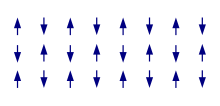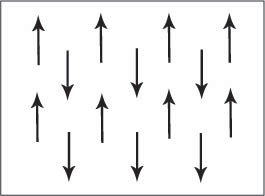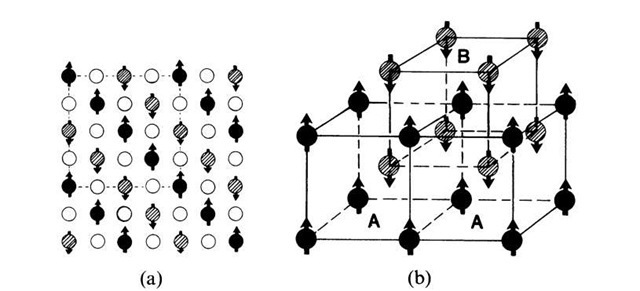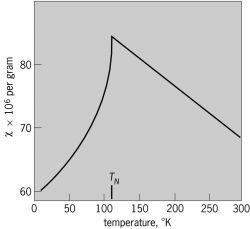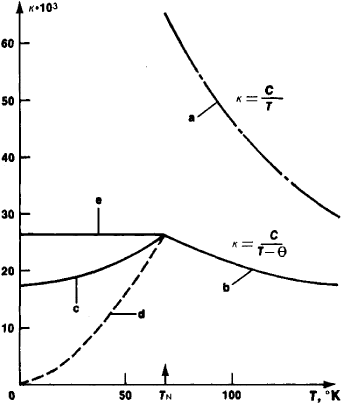Antiferromagnetism
The antiferromagnetism (Greek anti against αντί; Latin: ferrum iron, from Greek μαγνῆτις magnetis ( lithos ) stone from Magne Rhodesia ) is a cooperative, magnetic phenomenon, which has been thoroughly investigated, inter alia, from Louis Néel.
Overview
In this effect, the magnetic moments or spins of the atoms with a constant non-zero angle of rotation are aligned with each other and compensate each other exactly over the whole crystal. In the simplest case, this angle of rotation 180 degrees, so that the spins of atoms are adjacent to each other in anti-parallel.
The known ferromagnetism the spins on the other hand parallel to each other, thereby forming a macroscopic magnetization is established, whereas in the anti- ferromagnetism without an applied magnetic field, the resulting magnetization is zero. Both systems are stable only at sufficiently low temperatures. Antiferromagnetism when the permeability is a maximum at the phase transition temperature, the Neel temperature (named after Néel Louis ). Above the Néel temperature, in the magnetically disordered phase with largely arbitrarily oriented spins, the behavior of the material is paramagnetic, and the permeability decreases with increasing temperature.
The antiferromagnetic structure can be, just like other magnetic configurations, explain, particularly with the aid of an exchange interaction. Depending on its sign can be, for example, as part of an Ising model with couplings that are limited to neighboring spins easily describe ferro - or antiferromagnetic configurations of the magnetic moments. Längerreichweitige or competing interactions can lead to complex magnetic structures (eg to spiral structures ).
Clarification
The above-described Néel state ( with alternating spin directions ) is not, strictly speaking, the ground state of the system, but only a quasi- classical approximation for the particularly well for the description of excited states, the so-called spin waves, is, while the exact quantum mechanical ground state, except in special cases, is unknown, and in any case in the mentioned special cases extremely complex (for example, Bethe approach). In contrast, in the ferromagnetic case, the classical ground state (eg all spins up ) is exactly in the quantum mechanical formalism, and the description of excited states ( spin-wave ) corresponds to the case of ferromagnetism almost completely the classic image precessing vectors.
Literature
- Horst Stöcker: Paperback physics. 4th edition, published by Harry German, Frankfurt am Main 2000, ISBN 3-8171-1628-4
- Hans Fischer: Materials in electrical engineering. 2nd edition, Carl Hanser Verlag, Munich, Vienna, 1982 ISBN 3-446-13553-7
- Daniel Mattis: The theory of magnetism, two volumes, Berlin, Springer -Verlag, 1985 and 1988; ISBN 3540-10611-1 (there is also an older German -language version)

